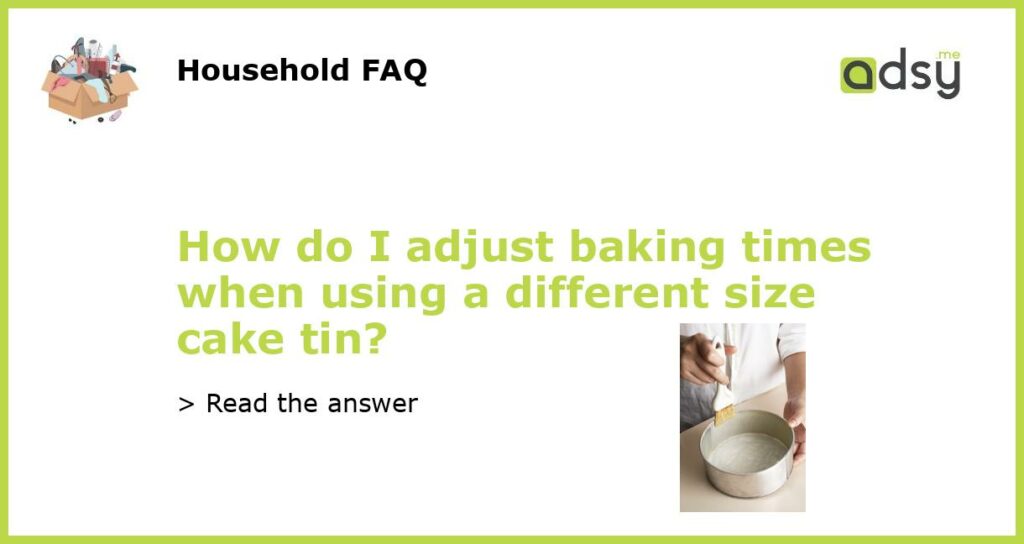Understanding the Basics of Baking Times
When it comes to baking, timing is everything. Baking times are typically provided in recipes to ensure that your cake comes out perfectly cooked – not underdone or overdone. But what happens when you want to use a different size cake tin than what the recipe calls for? Adjusting baking times becomes crucial to achieve the same delicious results. Let’s understand the basics of baking times and learn how to make the necessary adjustments.
Factors That Affect Baking Times
Before diving into the specifics of adjusting baking times, it’s important to understand the factors that can affect the baking process. These factors include:
- Size of the cake tin: Your baking time will vary depending on the size and shape of the cake tin you use. A wider and shallower tin will bake faster than a deeper tin.
- Batter volume: The amount of batter you use also affects baking times. If you have more batter in a larger tin, it will take longer to bake.
- Ingredients: Certain ingredients, such as moistening agents like applesauce or yogurt, can affect the baking process by adding extra moisture and changing the texture of the cake.
- Oven temperature: Oven temperatures can vary, and even a few degrees difference can impact baking times. It’s important to calibrate your oven regularly and adjust the temperature as needed.
Adjusting Baking Times: A General Rule of Thumb
While every cake recipe is unique, there is a general rule of thumb you can follow when adjusting baking times for different cake tin sizes. Here’s a simple equation:
Original Baking Time x (New Cake Tin Diameter ÷ Original Cake Tin Diameter) x (New Cake Tin Depth ÷ Original Cake Tin Depth)
Let’s break this equation down:
- Original Baking Time: This is the baking time specified in the recipe you are using.
- New Cake Tin Diameter: Measure the diameter of the cake tin you plan to use.
- Original Cake Tin Diameter: Measure the diameter of the cake tin specified in the recipe.
- New Cake Tin Depth: Measure the depth of the cake tin you plan to use.
- Original Cake Tin Depth: Measure the depth of the cake tin specified in the recipe.
By applying this equation, you can calculate the adjusted baking time for your specific cake tin size.
An Example to Understand the Calculation
Let’s say you have a recipe that specifies a 9-inch round cake tin with a baking time of 30 minutes. However, you want to use a 10-inch round cake tin instead. By using the equation mentioned earlier, here’s how you would calculate the adjusted baking time:
30 minutes x (10 inches ÷ 9 inches) x (same depth ÷ same depth)
The calculation would give you an adjusted baking time based on the relative size difference. In this case, it would be around 33.3 minutes. Keep in mind that this is a rough estimate, and you may need to monitor the cake closely towards the end of the baking time to ensure it is done.
Testing for Doneness
Regardless of the adjusted baking time, it’s crucial to test for doneness using other methods. While baking times can help guide you, other indicators will help you determine if your cake is fully cooked. Here are a few ways to test for doneness:
- Insert a toothpick: Insert a toothpick into the center of the cake. If it comes out clean or with a few crumbs, the cake is done. If it comes out with wet batter, it needs more time.
- Touch test: Gently press the top of the cake. If it springs back, it is done. If your finger leaves an indentation, the cake needs more time.
- Internal temperature: Use an instant-read thermometer to measure the internal temperature of the cake. For most cakes, it should read around 210°F (99°C) when fully cooked.
Baking with Confidence in Any Size Tin
Now that you understand the basics of adjusting baking times for different cake tin sizes, you can confidently bake delicious cakes using any tin you desire. Remember to account for the factors that affect baking times, use the general rule of thumb equation, and always test for doneness using multiple methods. With practice and a little experimentation, you’ll become a pro at adjusting baking times and creating mouthwatering cakes in any size tin.






